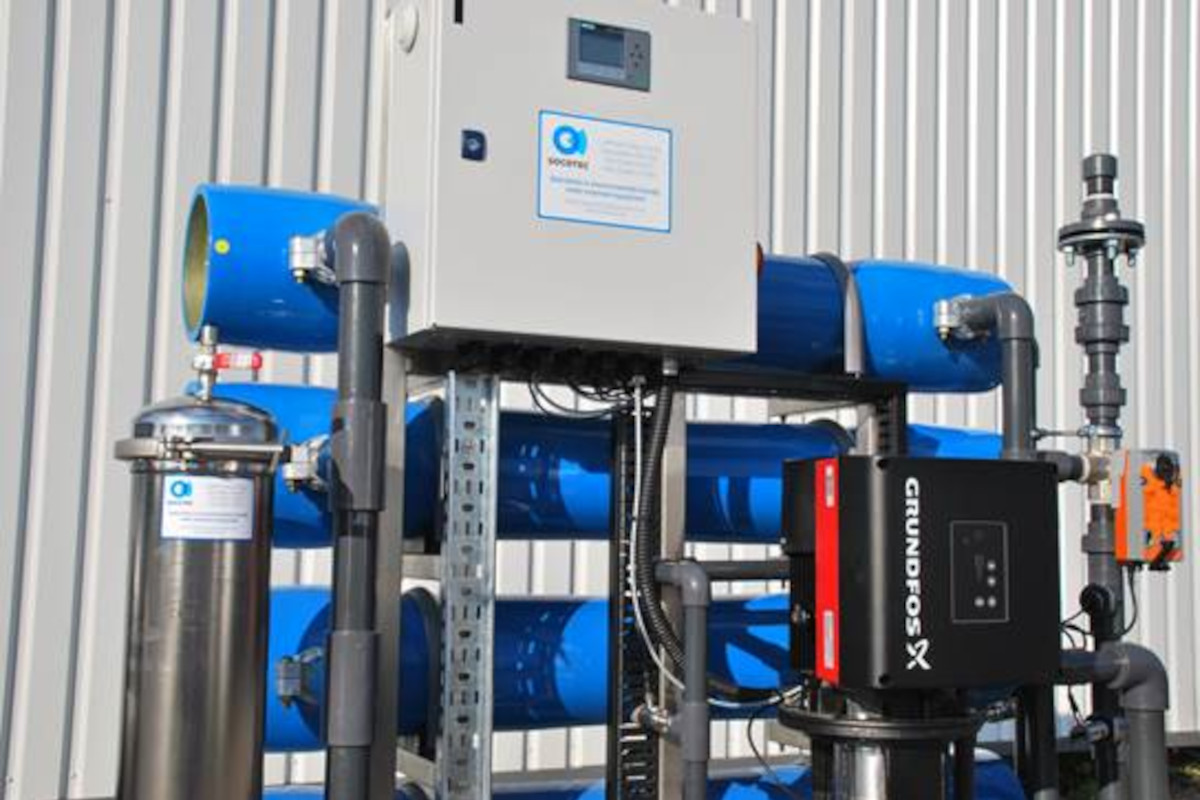
Stuart Malcolm, technical sales manager for SOCOTEC’s Water Treatment & Equipment team, answers a series of frequently asked questions regarding the importance of selecting the correct reverse osmosis plant for your water treatment requirements
Let us begin this article with a simple analogy. You are feeling unwell and visit the doctor, where they advise you to have a blood test in order to carry out a more in-depth analysis of your symptoms and subsequently identify the appropriate course of medical treatment. Instead, you decline this offer and state that they should provide you with whatever medicine they have available. While this is clearly not a sensible approach, why is this considered acceptable when it comes to selecting the correct Reverse Osmosis (RO) system for your application? The following FAQ is intended to help redress an all-too-common shortfall in guidelines when it comes to this aspect of water treatment.
What is reverse osmosis and how does it work?
Reverse Osmosis – commonly referred to as RO – is a water purification technology used to remove large molecules, contaminants, ions and salts from water. During this process, water molecules are pushed through a semi-permeable membrane to a diluted solution via a high pressure pump, allowing pure water through and leaving behind suspended particles, colloids, bacteria, viruses and salt, all of which are filtered out via a waste stream.
Where are Reverse Osmosis systems used?
RO systems are used for a range of applications, including but not limited to:
· Seawater desalination
· Ultra-pure water production (e.g for tap water)
· Purifying water for the pharmaceutical and medical industries
· Leachate treatment to remove toxite nitrates, organics and heavy metals
· Wastewater treatment
· Data centre cooling water
· Steam raising boiler feed.
What factors need to be considered when selecting the appropriate reverse osmosis system for my requirements?
Designing a Reverse Osmosis system requires an in-depth analysis of the feed water in order to determine the correct engineered solution and match this to a client’s requirements. There have been many occasions where SOCOTEC has been asked to design an RO system using ‘worst-case scenario’ water, a task which is not physically possible due to the unknown variables associated with water quality.
From mains water and borehole supplies to seawater and blackwater, each individual supply requires a detailed design that incorporates the correct pretreatment, membrane selection, membrane flux, high pressure pump requirement, permeate quality, percentage recovery, waste stream quality and disposal considerations. Therefore, when developing an RO system there are a number of areas that you will need to think about:
What information is needed in order to design a reverse osmosis system?
An analysis of the feed water provides engineers with relevant information about its chemical, physical and biological condition, which in turn can influence the design of the RO system. Chemical analysis provides information on ions such as calcium, magnesium, sodium, chloride, potassium, sulphate, fluoride and nitrate amongst others. Physical analysis provides detail on suspended solids and turbidity (the ability of water to let light pass through it), while biological analysis informs on coliforms, e-coli, chemical oxygen demand (COD) and total organic count (TOC).
What is the permeate water within reverse osmosis systems to be used for?
In some applications, reverse osmosis is required to turn a brackish water supply into a potable supply that is safe for consumption. In order to avoid removing all of the mineral content from the water, the best course of action would be to either blend a portion of the filtered raw water with the permeate water to achieve a neutral pH and an acceptable level of Total Dissolved Solids (TDS), or to add minerals to the permeate water (the product water from the RO unit, such as calcium carbonate).
Should the water be required for use within the pharmaceutical or electronic industries, where ultrapure water is required, a double pass RO system could be designed. The permeate water produced within the first RO system would be fed through a second RO system, resulting in very low conductivity. Recovery percentage of the second pass is normally high due to the quality of the feed water from the first RO.
Can I use nano-filtration as opposed to reverse osmosis?
The comparison between nano-filtration and reverse osmosis has been heavily debated in the water treatment industry, as they are two extremely similar technologies. Nano-filtration (also known as membrane softening) allows for calcium and magnesium removal, while still ensuring a large portion of the other ‘healthy’ minerals to remain in the water – many of which reverse osmosis has been known to remove. Nevertheless, reverse osmosis can still be considered as the most effective purification method, removing virtually all contaminates from the water to ensure it is suitable for the application.
How much permeate water does the client need and what time period is this required for?
Determining the volume of permeate water required by client allows water treatment technicians to identify how large the reverse osmosis system needs to be. If the water is required over a shorter time period, a smaller RO system can be designed that could feed into storage tanks. This could fill the tanks overnight, allowing for a production run the following day. However, if a 24-hour operation is required, a two-train system could be designed. When used in combination with storage tanks, this would allow one train to be taken offline for servicing while still maintaining permeate flow that allows for continuous production.
Are permeate storage tanks required within reverse osmosis systems?
Related to the question above, permeate storage tanks allow water treatment designers to determine the size of the RO system, meaning that it is extremely important to install the right amount of storage capacity. Too little and the client’s process could use more water than is available, yet too much capacity creates a risk of stagnation and contamination of the permeate water.
What space is required to install reverse osmosis equipment?
It is important to determine the amount of space available to install a Reverse Osmosis system. Pretreatment will need to be considered, including but not limited to water softeners, sediment filtration, activated carbon filters and clean-in-place (CIP) systems, as well as walk around and service space. A system can also be housed within a 20 or 40-foot shipping container, creating a ‘plug and play’ solution tailored to the customer’s requirements.
What kind of software is available for selecting reverse osmosis membranes?
Software that allows for the designing of RO systems is available via various membrane manufacturers. However, it is important to identify the exact data that is being entered and how this information is interpreted – for example, various sizes of membranes are available (namely 2.5”, 4” and 8”). There are also a number of membranes within each size selection, including extra low energy, low energy, tap water, brackish water, seawater, high rejection, fouling resistant, heat sanitising and nano-filtration.
This type of software also allows engineers to determine whether the flow across the membranes is too high or too low, whether the recovery rate can be increased to prevent unnecessary water wastage, as well as identifying the curve and power requirement of the high pressure pump. SOCOTEC can distinguish the scaling indices of the water and determine whether or not a water softener/anti-scalant chemical should be implemented in order to prevent calcium carbonate fouling in the final stage of the system.
How can SOCOTEC help?
As part of SOCOTEC’s comprehensive water treatment equipment offering, our reverse osmosis systems are designed in-house and are available for purchase. These can be designed and built to meet the needs of each individual client, with maintenance also offered as part of the service to ensure the longevity, efficiency and quality of your water system.
Do you require further information on SOCOTEC’s filtration solutions? Click here.






